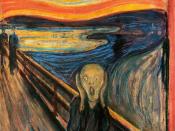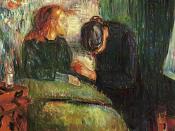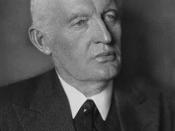We want more than a mere photograph of nature. We do not want to paint pretty pictures to be hung on drawing-room walls. We want to create, or at least lay the foundations of, an art that gives something to humanity. An art that arrests and engages. An art created of one's innermost heart." (E.M.)
Edvard Munch was born December 12, 1863 in Loten, Norway. He was one of five children born to Christian Munch, a military doctor, and his wife Catherine. Munch's life was always filled with death and morbidity. In 1868, his mother died of tuberculosis. In 1877, his younger sister Sophie also died of tuberculosis. Many of his pictures of death rooms, sick and dead children, and sick and dead mothers were inspired by the illness, death, and grief that had haunted him in his early years.
Edvard himself was also often ill. Edvard entered a technical college to become an engineer in 1879, but frequent illness drove him away.
In 1880 he decided to leave school to study painting. The next year, he enrolled in the Royal School of Art and Design where he painted his first self-portrait.
For a time, Norway's leading artist, Christian Krohg, instructed Edvard. At that time Edvard also was greatly interested in French Realism, which one can see traces of in his early works. In 1885, Munch went to Paris to study. There he began a work called The Sick Child, which soon would be his breakthrough. In it he made a radical break with the realistic approach of the time. The picture was about his sister Sophie, and her death from Tuberculosis. Munch struggled with the interpretation of his experience, and the pain and personal meaning that it held. Finally, he finished a coarsely textured, laborious picture. The critics were...


